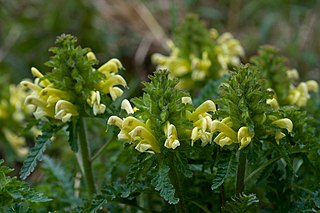
Pedicularis canadensis, commonly called Canadian lousewort or wood betony, is a flowering plant in the family Orobanchaceae. It is native to North America, where it is found in southeastern Canada, the eastern United States, and eastern Mexico. It has a wide-ranging natural habitat, being found in mesic to dry, forests, woodlands, and prairies.

Pedicularis is a genus of perennial green root parasite plants currently placed in the family Orobanchaceae.

Junkerdal National Park is a national park in the municipalities of Saltdal and Fauske in Nordland county, Norway, along its border with Sweden. The 682-square-kilometre (263 sq mi) park opened in 2004. It borders the Junkerdalsura nature reserve.

Pedicularis furbishiae, or Furbish's lousewort, is a perennial herb found only on the shores of the upper Saint John River in Maine and New Brunswick. Furbish's lousewort was first recognized as a new species by Maine naturalist and botanical artist Kate Furbish in 1880. It is considered an endangered species in the United States and Canada, and is threatened by habitat destruction, as well as riverside development, forestry, littering and recreational use of the riverbank. It was formerly in the family Scrophulariaceae, but is now placed in the family Orobanchaceae. Once thought to be extinct, it is considered a Lazarus taxon.

Pedicularis groenlandica is a showy flowering plant in the family Orobanchaceae which is known by the common names elephant's head, elephant-head lousewort and butterfly tongue.

Pedicularis contorta is a species of flowering plant in the family Orobanchaceae known by the common names coiled lousewort and curved-beak lousewort. It is native to western North America, including southwestern Canada and the northwestern United States, where it grows in moist mountainous habitat, such as bogs, shady forests, and meadows. It is a perennial herb producing one or more stems up to 40 centimetres (16 in) tall from a caudex. The leaves are up to 18 centimetres (7.1 in) long, lance-shaped to oblong, and divided into many linear lobes which may be toothed or smooth-edged. The inflorescence is a raceme of flowers occupying the top of the stem. Each flower is a centimeter long or slightly longer, white to yellowish in color, and divided into a coiled or curved beak-like upper lip and a flat, three-lobed lower lip. The fruit is a capsule up to a centimeter long containing seeds with netted surfaces.
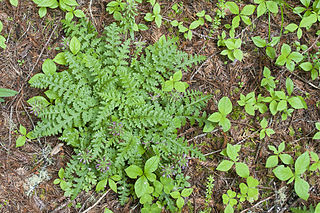
Pedicularis dudleyi is a rare species of flowering plant in the family Orobanchaceae known by the common name Dudley's lousewort. It is endemic to central California, where it is known from about ten scattered occurrences along the coast and in the coastal mountain ranges. It has been found in three locations along the Central California coast. The species was named for 19th-century Stanford University botanist William Dudley.
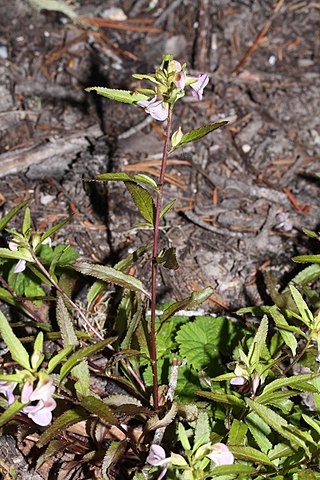
Pedicularis racemosa is a species of flowering plant in the family Orobanchaceae known by the common names sickletop lousewort and leafy lousewort. It is native to western North America, where it grows in coniferous forests. This is a perennial herb producing several stems up to 80 centimetres (31 in) tall, greenish to dark red in color. The leaves are up to 10 centimetres (4 in) long, linear in shape and lined with teeth. The inflorescence is a small raceme of flowers occupying the top of the stem. Each white to light purple or yellow flower is up to 1.6 centimetres long and is divided into a curved or coiled beak-like upper lip and a wide three-lobed lower lip. The fruit is a capsule over a centimeter in length containing smooth seeds.
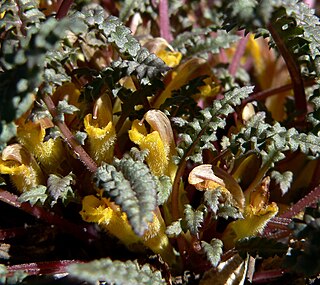
Pedicularis semibarbata, known by the common name pinewoods lousewort, is a species of flowering plant in the family Orobanchaceae.
P. palustris may refer to:
P. canadensis may refer to:
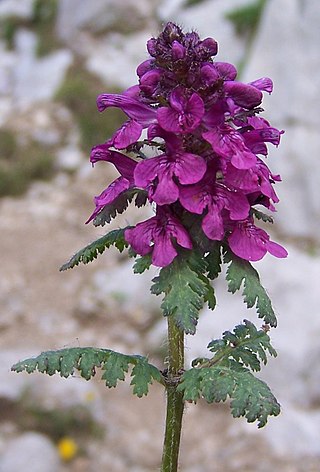
Pedicularis verticillata, the whorled lousewort, is a species of flowering plant in the family Orobanchaceae which can be found in Alaska, North-Western Canada, and everywhere in China at the elevation of 2,100–4,400 metres (6,900–14,400 ft). Its native habitats include moist meadows and lakeshores.
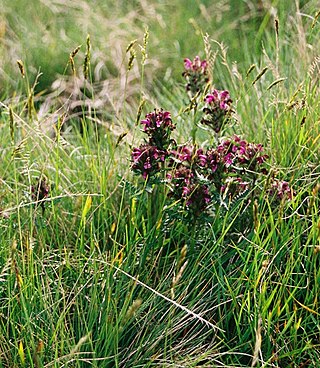
Pedicularis sudetica, common names of which are fernweed, Sudeten lousewort, Sedetic lousewort, and Sudetic lousewort is a species of flowering plant in the family Orobanchaceae which is native to Poland, the former Czechoslovakia, and northern Russia to the Urals, but can now be found in such US states as Alaska, Colorado, New Mexico, Wyoming, and Canada since it was introduced there. The plant is both perennial and bisexual. It grows 0.3 m high with the flowers being hermaphrodite.

Bishop Monkton Ings is a Site of Special Scientific Interest, or SSSI, situated east of Bishop Monkton village in North Yorkshire, England. It consists mostly of marshy, calcareous grassland, with some broadleaved woodland, and some fen alongside the two watercourses which run through the site. This varied wetland forms a habitat for a variety of plants, including the semi-parasitic marsh lousewort (Pedicularis palustris).
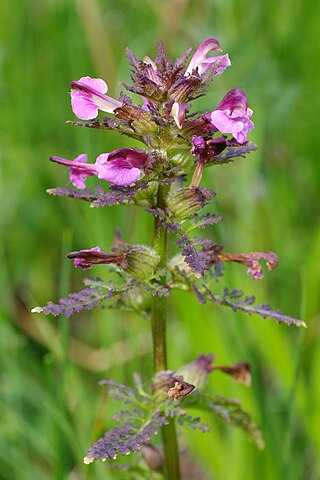
Pedicularis palustris, commonly known as marsh lousewort or red rattle, is a plant species in the family Orobanchaceae. It is native to central and northern Europe and Asia where it grows in wetlands and boggy habitats. The International Union for Conservation of Nature has assessed its conservation status as being of least concern.
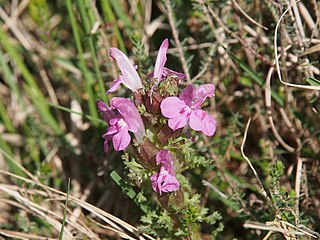
Pedicularis sylvatica, commonly known as common lousewort, is a plant species in the genus Pedicularis. It is native to central and northern Europe where it grows on moist acidic soils, moorland, grassy heathland and the drier parts of marshes.
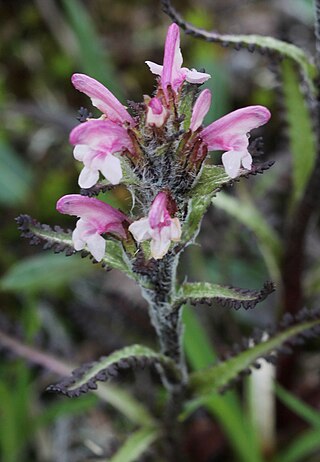
Pedicularis hirsuta, commonly known as Hairy Lousewort, is a species of flowering plant belonging to the family Orobanchaceae.

Pedicularis bracteosa also known as bracted lousewort is a flowering deciduous perennial plant with alternating cauline leaves that are linear/oblong to lanceolate, approximately 1 to 7 cm long. It has fibrous roots and grows to approximately 1 meter high. Its flowers form in densely clustered spike raceme, and range in color from yellow to bronze to red to purple. Its distribution is found in western North America including New Mexico, Colorado, Montana, mountainous parts of Washington and California, and in British Columbia.
















